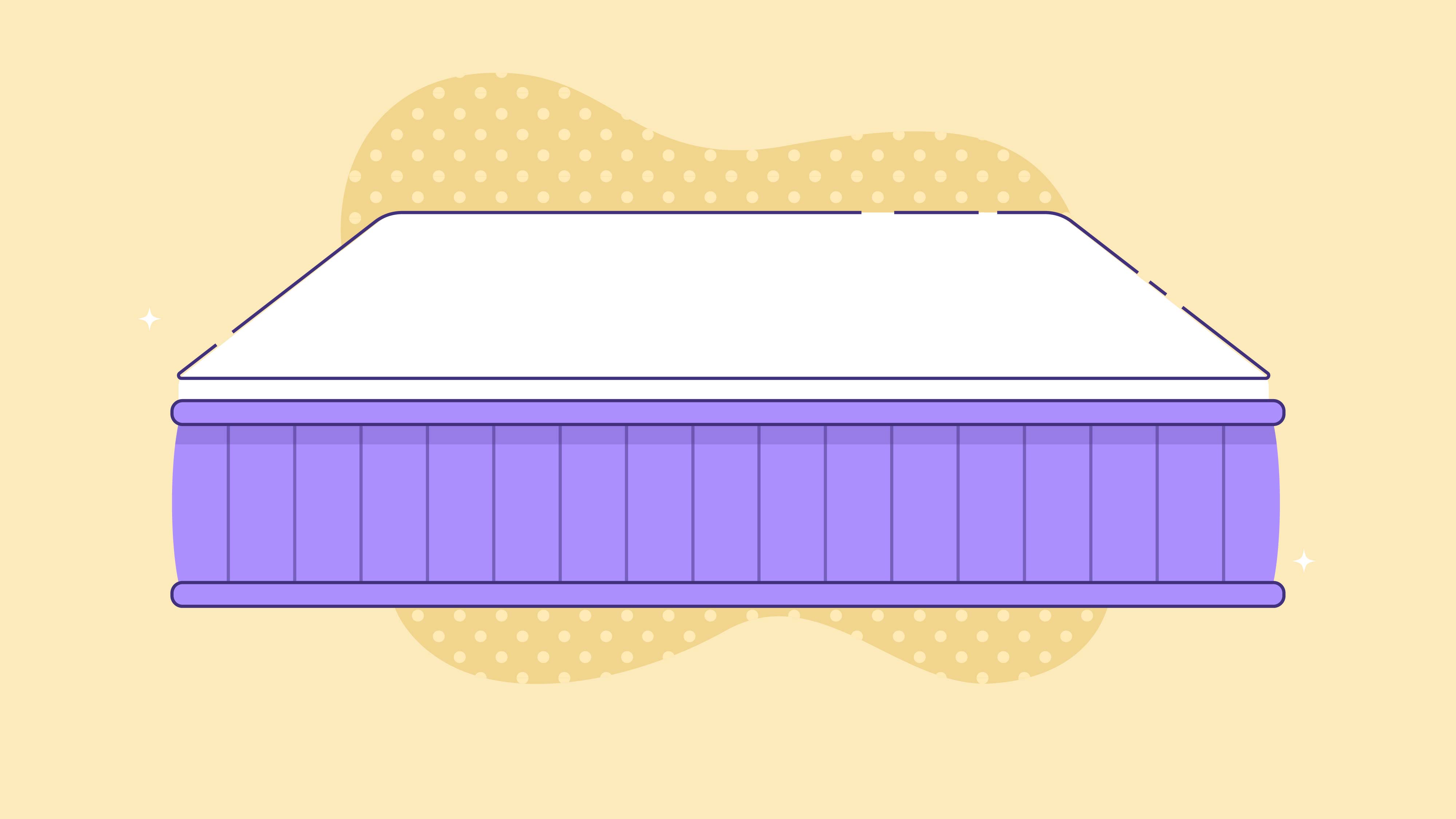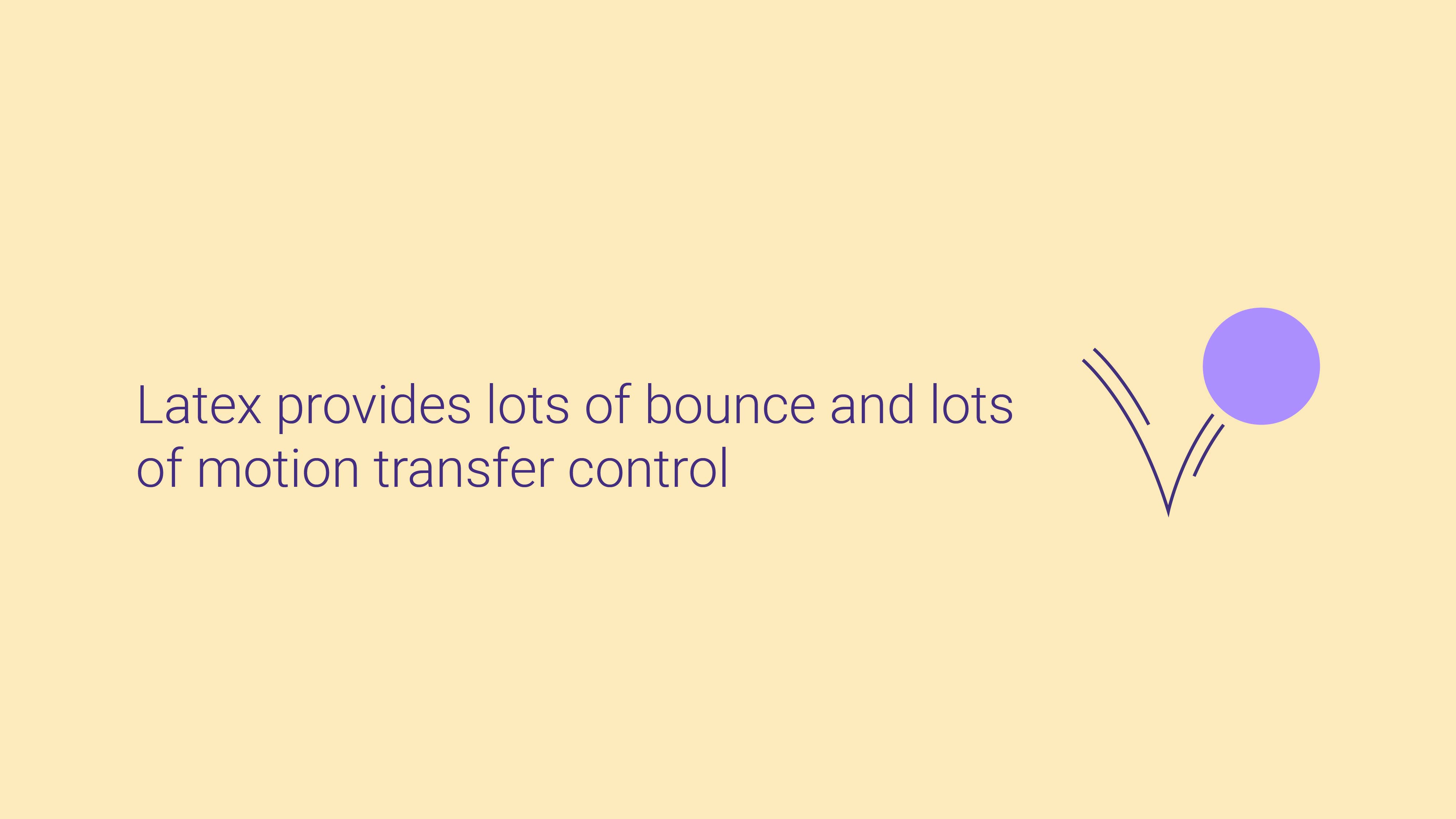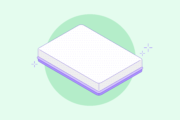
Latex Mattress Buying Guide

- Latex stands out as a mattress material due to its delightful springiness, natural cooling, and exceptional comfort, making it a strong contender in the market.
- Dunlop latex offers a denser, more affordable, and eco-friendly option, while Talalay latex provides a springier feel with enhanced breathability, though it is less supportive and not as eco-friendly.
- Latex mattresses, despite their higher initial cost, prove to be a cost-effective choice with exceptional durability lasting over two decades, and considerations such as firmness, sleep position, and certifications like GOLS, GREENGUARD Gold, and OEKO-TEX play key roles in selecting the right one.
Latex is one of the best mattress materials on the market today. It’s delightfully springy. It’s naturally cooling. And it’s one of the purest, most natural materials available. In terms of comfort, not many other mattress materials can compete with latex foam.
However, latex mattresses do have a couple of drawbacks potential buyers should be aware of as they shop. Below, we’ll talk about what’s great about natural latex, what’s not so great about it, and how to decide if it’s the right mattress material for you.
Dunlop vs. Talalay Latex
Natural latex foam comes in two different varieties: Dunlop and Talalay. Dunlop latex and Talalay latex both come from the sap of the rubber tree. The only difference between the two is how the raw sap is processed.
The two different processing methods create two different feels. The Dunlop method creates a denser and less bouncy foam. The Talalay method creates a springier and more breathable foam. Talalay latex will be more contouring but less supportive, while Dunlop latex will be denser and have more lift.
However, keep in mind that these latex varieties aren’t all that distinct. The differences in feel should feel pretty minimal for most people.
Dunlop
Dunlop latex is the more energy-efficient of the two latex foams. That translates into a slightly more affordable and more eco-friendly mattress. Dunlop latex is made by simply whipping purified rubber tree sap into a foam, pouring it into a mold, and zapping it in a vulcanization oven. Then, the baked foam is washed and dried.
This simpler process creates a denser and more durable latex that’s heavier on the bottom than the top. Dunlop latex is also purer than Talalay. Since it doesn’t require many of the processing chemicals that Talalay does, Dunlop latex is the only latex type certifiable under the Global Organic Latex Standard (GOLS).
Talalay
Talalay latex is springier and less dense than Dunlop latex, but it’s less eco-friendly and less pure. Natural Talalay latex cannot be certified organic under GOLS because of the processing chemicals required in its manufacturing. Don’t let that scare you off, though. This type of latex is still perfectly safe and all-natural, and it can be certified under other certification standards.
Talalay latex is manufactured by pouring liquid latex into a mold, just like with Dunlop. Unlike with Dunlop, the Talalay latex is only poured halfway up the mold. It is then vacuum sealed and allowed to proof until it fills up the mold. It’s then flash-frozen before being vulcanized. Finally, the vulcanized Talalay is washed and dried to remove impurities.
Feel
Natural latex foam has a delightful feel that offers pressure relief and spinal support. Latex wants to retain its shape, so it’s not as contouring as memory foam. Some people may find the lowered contouring of latex annoying, but most people won’t notice much difference.
This is especially true of lighter Talalay latex. Natural Talalay latex is more contouring than denser natural Dunlop latex. That means if you want a latex mattress that feels just like memory foam, a mattress with a Talalay comfort layer above Dunlop bottom layers is your best option.
Responsiveness
Latex provides lots of bounce and lots of motion transfer control. Unlike memory foam, latex bounces back to its original shape without a lot of lag time. This can be especially enjoyable to active sleepers who like to toss and turn all night. And you get all this responsiveness without sacrificing motion isolation.
Temperature Regulation
Hot sleepers will appreciate latex’s breathability. Memory foam requires lots of modifications to make a cooling mattress. It needs gel or copper infusions, microbeads, open-cell construction, and more.
Latex, meanwhile, is naturally cooling. One of the benefits of latex is that it doesn’t need a bunch of infusions or chemical additives to make it conductive. It pulls your body heat away from you all on its own.
Certifications
Certifications can attest to latex’s purity, environmental friendliness, ethicality, or all three. Certain certifications are also the difference between an organic and natural mattress. Noteworthy certifications concerning latex mattresses include:
- Global Organic Latex Standard
- GREENGUARD Gold
- OEKO-TEK Standard 100
- Global Organic Textile Standard
- Rainforest Alliance
- eco-INSTITUT
Global Organic Latex Standard (GOLS) is the gold standard for organic latex. Latex certified under GOLS has to adhere to strict standards for purity, ecological impact, and social responsibility.
Not only does GOLs-certified latex have to be free of toxic and synthetic chemicals. Its harvesting and manufacturing processes have to strictly limit toxic waste production. And they cannot exploit their workers at any point in the process.
Other solid certifications to look for include ones from GREENGUARD Gold and OEKO-TEK. GREENGUARD Gold certification indicates a product contains few to no volatile organic compounds (VOCs) and will not negatively impact indoor air quality. OEKO-TEX Standard 100 also indicates that a product is free of harmful substances like heavy metals and formaldehyde.
Price
Latex is not cheap, and organic latex is even less so. From the standpoint of initial cost, latex has the highest average price tag. At $2,000 for a queen, the average upfront price for a latex mattress comes in slightly above $1,700 hybrid mattresses and well above $1,100 memory foam ones.
That means you need to be prepared to pay a premium if you want a latex mattress. Still, latex beds are often some of the best mattresses under $2000.
Durability
Despite latex’s high initial cost, its durability makes up for the upfront expense. Latex smokes every other type of mattress in terms of longevity. You can expect to get at least two decades out of an average latex mattress. If you purchase a Dunlop latex mattress and take measures to maintain it, you could get 30 or possibly even 40 years out of it.
That means latex’s lifetime cost is actually a lot lower than that of hybrids (which only last around 15 years). Even memory foam’s lower initial cost is offset compared to latex because memory foam is very unlikely to last longer than 20 years. Most memory foam mattresses make it to 10 or 15.
Warranty and Sleep Trial
All high-quality mattresses should have an excellent warranty and robust sleep trial. Good minimums to look for are at least a 10-year warranty and a 100-night sleep trial. These features indicate that a manufacturer is willing to stand behind their product.
Read the fine print when you’re looking at the warranty and trial period. Warranties should cover all manufacturer-caused problems like premature aging and defects.
Sleep trials should have a money-back guarantee. That means you can return the product for any reason within the allotted number of days and expect a full refund. Look for words like “risk-free” or “satisfaction guarantee.”
Firmness
Like all types of mattresses, latex mattresses come in a range of firmness levels. That means you can have a latex mattress no matter what sleeping position you prefer or what body type you have.
Sleep Position
Your sleep style is the primary factor that determines your firmness needs. How you sleep determines what portions of your body make contact with the bed and, therefore, what areas need support and cushioning.
Side sleepers need the softest beds (usually 3 or 4 out of 10 on the firmness scale). When you sleep on your side, you need lots of cushioning to relieve pressure on the hips and shoulders. Otherwise, you could experience pain in these pressure points.
Combo sleepers and back sleepers need middle-of-the-road firmness levels. A mattress for combination sleepers needs a versatile feel that can accommodate multiple sleeping positions. A medium (5) should work for most combo sleepers.
Back sleepers need a combination of support and cushioning to keep the lumbar region supported and the spine aligned. Medium-firm mattresses (6) offer the right balance of lift and cradling for back sleepers’ backs.
Stomach sleepers need the firmest mattresses (7 to 8). This firmness level will keep the pelvis lifted onto the sleeping surface. A firm mattress prevents lower back pain by encouraging spinal alignment and averting over-arching in the spine.
Body Type
Your body type also has an impact on how firm your mattress should be. If you’re between 130 and 230 pounds, you can generally stick to the firmness level that corresponds to your sleep style. However, if you’re a petite sleeper (under 130 pounds) or a plus-size sleeper (over 230 pounds), you’ll need to take your weight into account.
Petite sleepers may need to go down a firmness level to get enough compression to cradle their pressure points. Plus-size sleepers need to do the opposite. To avoid sinkage, they’ll need to go up a firmness level. Firmer mattresses help to keep the body on top of the sleeping surface. This will keep the spine from falling out of alignment.
Other Latex Options
Besides pure natural latex, there are a few other options for you to choose from as you shop.
Latex Hybrid
Latex hybrid mattresses are an excellent option for those who are sick of saggy, squeaky innerspring mattresses but don’t want to give up their coils. Hybrid mattresses combine at least two inches of foam in the comfort layer with a support core of pocketed coils.
Don’t be fooled by pillow-top innerspring mattresses. Some mattress companies slap a foam pillow top on a traditional innerspring mattress and call it a hybrid. However, if the comfort layer isn’t at least two inches thick or the support core isn’t made of individually wrapped coils, it isn’t a hybrid.
Most hybrid mattresses employ memory foam in their comfort layers. However, latex hybrids combine all the breathability and responsiveness of latex with even more breathable and bouncy coils. The design creates a mattress with all of the pros of an innerspring and none of the cons.
Latex hybrids are a wonderful alternative to pure latex foam mattresses for those who want some extra responsiveness and airflow. The coils allow air to circulate throughout the mattress and add bounce to the comfort layer. And the latex protects your body from pressure exerted by the coils and adds even more contouring to an already adaptable support core.
Latex hybrid mattresses are a major upgrade over memory foam hybrids for those looking for all-natural materials without a bunch of synthetic ingredients. With a latex hybrid, you can still have all-natural Talalay latex or organic Dunlop latex. You could even have a combination of the two with a Talalay comfort layer and a Dunlop transition layer between the top layer and coils.
One thing to keep in mind is that a latex hybrid will not last as long as a pure latex mattress. The coils break down faster than the latex foam. That means your mattress will sag faster if it has a coil support core instead of a latex foam support core.
So how long does a latex mattress last? You’ll get 15 to 20 years out of a latex hybrid but a minimum of 20 years from a pure latex foam mattress.

Synthetic Latex
On the other hand, synthetic latex is one material to approach cautiously. Synthetic latex is also known as Styrene-Butadiene Rubber (SBR). SBR is created by processing petroleum products into a foam that claims to mimic the feel of natural latex. This product is common in shoe soles, yoga mats, tires, and other similar items.
Synthetic rubber is also a key ingredient in mattresses marketed as affordable alternative latex. However, these mattresses might be affordable, but they’re anything but an adequate alternative to natural latex.
SBR is not breathable. It’s not responsive. It’s not supportive. It’s not durable. And perhaps worst of all, it’s full of synthetic and potentially toxic chemicals that even memory foam likely doesn’t have. Despite being synthetic, CertiPUR-US® certified memory foam is actually quite low in VOCs and harmful chemicals. Most SBR doesn’t come with the same guarantee.
SBR usually comes in cheaply made, bottom-of-the-line mattresses that won’t last very long or do their job of offering a good night’s sleep. If you’re looking for a more affordable alternative to natural latex, memory foam is a superior choice to synthetic latex.
Memory Foam
Memory foam is a special type of flexible polyurethane foam that is designed to support and cushion your body. Traditional memory foam is not as responsive or as breathable as latex. It’s also not all-natural since it’s made of polyurethane. However, there are a couple of reasons you might choose memory foam as an alternative to latex, as our memory foam vs latex guide details.
First, if you need the most contouring and cushioning material on the market, memory foam is it. Memory foam can follow the curve of your body to fill in gaps in your waist or lumbar region and cushion your pressure points in a way latex just can’t. If you need ultimate pressure relief, memory foam is a great choice.
Another reason you might choose memory foam over latex is your budget. A memory foam mattress might wind up costing a little bit more than a latex one in the long run because it will need to be replaced sooner. But memory foam is a lot more affordable than latex upfront. If you just can’t pay a high initial price for a mattress, it’s easy to find a quality memory foam bed for under $1,000.
If coolness on a budget is a concern, sleepers may want to consider a gel memory foam mattress. The infused gels increase memory foam’s heat-wicking capabilities, bringing it closer to latex’s cool feel. Our gel memory foam vs latex guide compares the two in depth.
See our memory foam mattress buying guide for more information.
FAQs
Do latex mattresses experience off-gassing?
Off-gassing is when a mattress or other product emits VOCs and other chemicals from the manufacturing process into the air around it. When you get a memory foam mattress, you’ll probably catch a whiff or two of that “new mattress smell” when you open the packaging. That smell is part of the off-gassing process.
Natural latex does not off-gas. Since natural latex is made from rubber tree sap, it doesn’t have the VOCs that memory foam does. You should not smell any chemical odor from a pure natural latex mattress. If your latex mattress has layers of polyfoam or other foam, it may off-gas.
While off-gassing shouldn’t put you in any real danger, it could cause mild symptoms like headache and sore throat. You can avoid it altogether by buying a latex mattress, but it’s important for you to know the chemical makeup of each layer of your mattress before you purchase so you don’t wind up with any surprises.
Is memory foam as good as latex?
That depends on what you’re looking for in a mattress. If you want the ultimate contouring and pressure relief, then memory foam is actually better than latex. Memory foam doesn’t hold its shape at all. It molds itself to your shape to offer you unbeatable cushioning and customizable support.
However, latex beats out memory foam in other aspects. Latex is definitely superior to memory foam in terms of responsiveness. Latex is the ideal choice if you want a mattress that bounces back as soon as you change positions.
Latex is also cooler than memory foam. Even memory foam with infusions to increase thermal conductivity just can’t compete with breathable, pleasantly chilly latex. That means hot sleepers will likely prefer latex over memory foam.
Can latex help fight my allergy symptoms?
Yes—as long as you’re not allergic to latex. For those who don’t have a latex allergy, latex foam is an excellent hypoallergenic option. Latex resists moisture buildup, which helps fight everything from mold and mildew to bacteria and dust mites. Latex is resistant to just about every common allergen.
Those who have a latex allergy should avoid a latex mattress. While the mattress cover and mattress protector sit between you and the actual latex, there’s always a possibility of exposure to the latex foam.
If you have a latex allergy, memory foam is a better choice. Plant-based memory foam swaps select petroleum products for plant oils and is a natural option for those who don’t want an entirely synthetic foam. It’s still breathable and responsive, without the risk of triggering a potentially dangerous reaction.
Which is better, pure latex or a latex hybrid?
Your personal preferences are the deciding factor here. If you want one of the most durable mattresses that will not have to be replaced for a few decades, pure latex foam is the right choice for you. If you want the bounce and airflow of coils and the springy contouring of latex, a latex hybrid will be your best bet.
Straight-foam latex mattresses and latex hybrids will both be responsive and breathable. They will also both be adaptable to offer you contoured support. The main difference between the two in terms of feel is the bounce. The coils inside a latex hybrid bounce similarly to the coils in an innerspring. If you’re used to that bounce, you will probably prefer a hybrid.
The tradeoff is durability. Those bouncy coils will shave years off the life expectancy of your latex mattress. At the same time, a steel coil core is usually less expensive upfront than a latex foam core.
How much should I pay for a latex mattress?
Latex is very expensive, even if it’s not organic. The average price for a queen latex mattress is $2,000. This is because natural latex is not cheap to produce. Trees have to be grown and tapped. Rubber sap has to be harvested and processed. Heavy latex foam has to be shipped. Everything has to be certified according to the appropriate standards.
Depending on the size, brand, and whether the latex in your mattress is certified organic, you should be budgeting anywhere from close to $1,000 for a twin or twin XL to $3,500 for a larger size like a king or California king.
Bottom Line
Latex is an excellent mattress material. It’s responsive, breathable, pure, and supportive. The only real downside to latex is its high initial price. However, that downside is offset by latex’s unbeatable durability. Latex can last and last. That means you’ll wind up paying less for it over the course of its lifetime than you would for other mattress types. What’s not to love?



